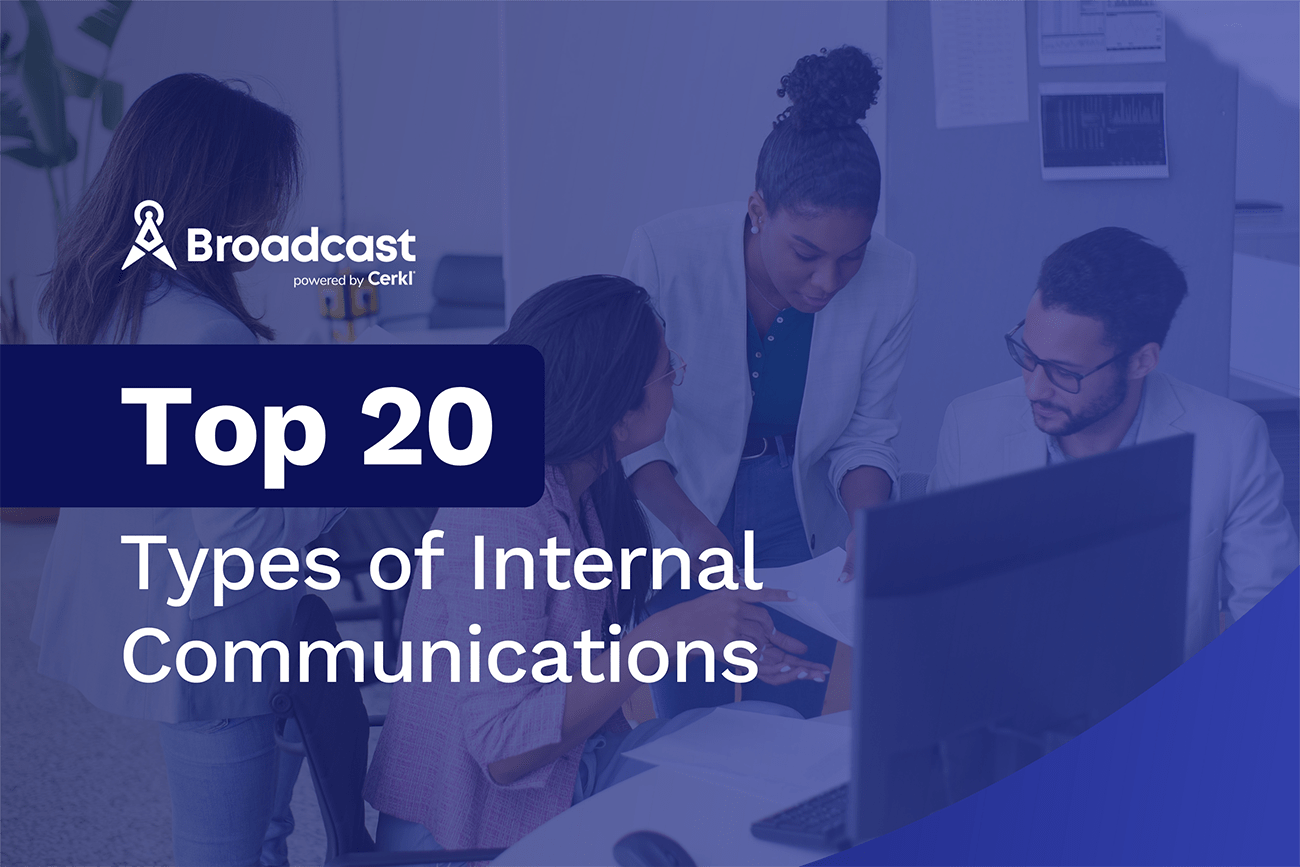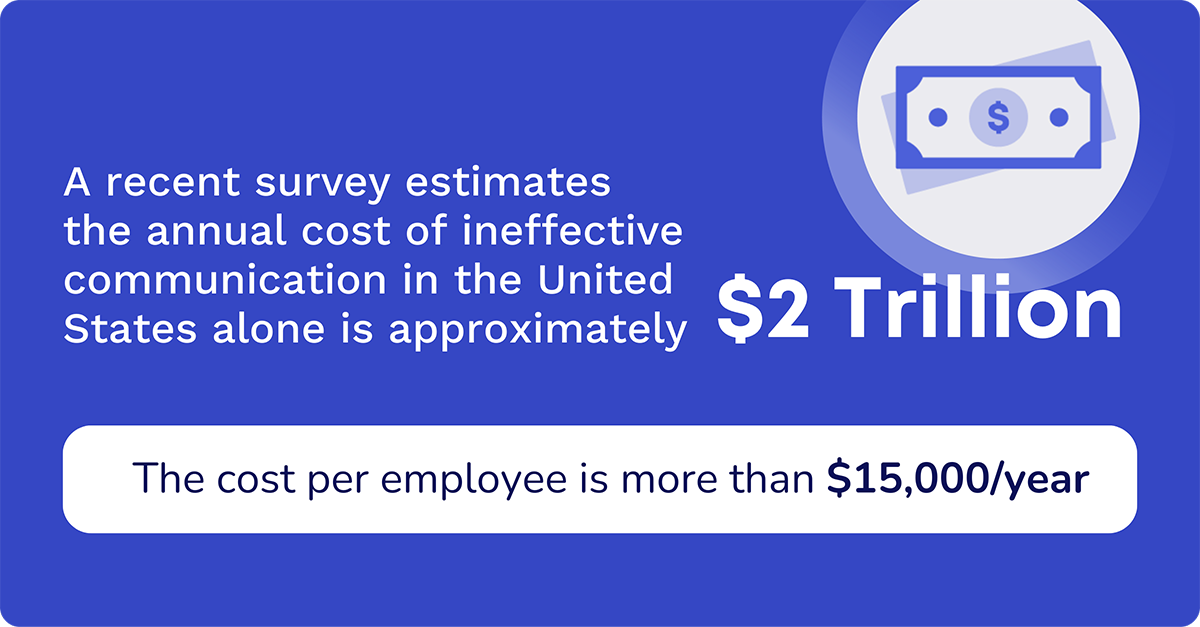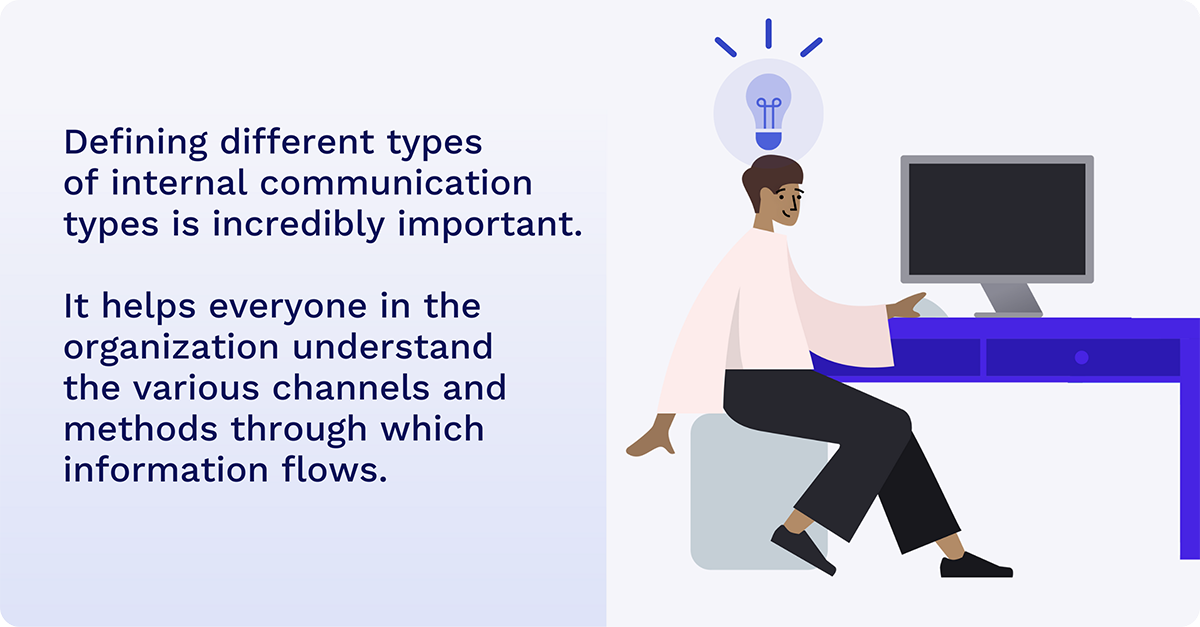 Employee Communication Best Practices
Employee Communication Best Practices
Communication encompasses a wide range of types and forms. Discover which types of internal communication will best benefit your organization.


Choosing the right internal communications software is a delicate process. Evaluate yourcommunication goals and needs, and select the right software with confidence using our Internal Communication Software Buyer’s Guide.
Access NowInternal communications form the backbone of any business. It fosters a culture of transparency, enhances productivity, and builds a sense of shared purpose.
According to recent research, 93% of business leaders say their ability to get work done depends largely on how effectively their collaborators communicate their requirements or articulate their ideas. And 72% say that effective communication results in increased productivity.
There are multiple types of communication and diverse ways we can relay messages within an organization. For this reason, understanding the different types of internal communication is vitally important.
We accept that identifying different types of internal communication can be a challenge. For example, there are people who maintain there are four main types of communication and others who say there are at least eight types you should be incorporating in your business communication plan. Some say the four types of communication are leadership, peer-to-peer, management-to-employee (which is top-down), and employee-up (which is bottom-up). Others take the approach that the four main types of communication are verbal, nonverbal, written, and visual.
Dr. Daria S. LaFave, a communication instructor at Southern New Hampshire University (SNHU) in Manchester, New Hampshire, categorizes the four main types as passive, aggressive, passive-aggressive, and assertive. It’s a completely different approach.
Do a bit more searching and you’ll find people who extend the number to five, six, or eight. It all depends on their emphasis. This is simply because people categorize and conceptualize communication differently. Ultimately, it reflects the diversity and complexity of communication — and it’s all important.
There are many different elements we need to consider when defining types of internal communication. So, we’ve taken the idea a big step further and have come up with a comprehensive list of 20 different types. We start with the basic, better-known top-down and bottom-up types and then expand the categories to embrace a whole lot of types that meet the needs of specific situations. These range from change and crisis communication to more informal holiday communication. By exploring each of these unique types, we hope you will be inspired to expand your organization’s internal communications strategy, improving it and making it more effective.
We’re also going to discuss why different types of internal communication matter, and suggest ways to build an effective communication strategy that will work for your organization.
Internal communication holds unparalleled potential in creating a unified workforce, forging a culture of collaboration, and driving company growth. As such, it's the lifeline that ensures the seamless transfer of company updates, employee recognition, and all the other important communications types organizations need to share.
A recent survey that involved 540 business leaders and more than 1,000 employees, estimates that the annual cost of ineffective communication in the United States alone is approximately $2 trillion. It puts the cost per employee at more than $15,000 per year.

Incredibly, more than half of the business leaders said the major challenge was sharing essential communications. These are the constant updates that keep everybody, including employees and stakeholders, aligned. Almost as many (47%) said that the main stumbling block was being able to write in “a concise, engaging way people will actually read.” Additionally, the survey found that:
For any firm looking to enhance its engagement levels, deploying an effective internal communications strategy is a must. Believe it or not, employee engagement drives everything — productivity, innovation, and even bottom-line business results.
According to Gallup's 10th, most recent, employee engagement meta-analysis, companies with highly engaged workforce experienced an 18% increase in productivity (sales), a 23% increase in profitability, and a 43% increase in turnover. In addition, they found that absenteeism dropped by 81%.
We believe that defining different types of internal communication types is incredibly important. It helps everyone in the organization understand the various channels and methods through which information flows. This clarity reduces confusion and ensures that everyone is on the same page. It allows organizations to strategically plan how information should flow. This helps information communicators determine which types of communication are most effective for specific messages or situations.

Knowing the different types of internal communication enables organizations to implement communication strategies more effectively. It ensures that the right messages reach the right people through the most appropriate channels. It also guides communicators, helping them to implement communication strategies more effectively. At the same time, a good strategy ensures that the right messages reach the right people through the most appropriate channels.
We cannot ignore the all-important element, employee engagement. By defining different communication types, it’s easier to tailor communication strategies to enhance engagement. There is no doubt that recognizing the diversity of communication needs among employees helps in creating more engaging and relevant communication.
Ultimately, by analyzing the effectiveness of different communication types, organizations can continually improve their internal communication processes. Don’t ever forget that this includes getting continuous feedback, adapting to changing needs, and refining strategies over time.
Turn your internal communications strategy around today

Now that we understand why internal communication is significant, we’re going to take a closer look at its key components.
The first and perhaps the most critical component is a well-planned internal communication strategy. This strategy should align with the goals and culture of communication within the organization. Additionally, it should be flexible enough to allow for change management and vital, usually inevitable crisis communications.
The right internal communications app or platform can empower internal communicators, presenting them with numerous communication options including employee emails, newsletters, and survey options.
Employee engagement is another vital facet of internal communication, and it’s one we have already discussed. But what’s important here is for any internal communications team to make sure they provide employees with tools that allow plenty of feedback options. Additionally, employee engagement strategies for communication include the use of peer recognition systems, pulse surveys, and virtual meetings.
Additionally, the importance of leadership communications in internal communication cannot be understated. Leaders have the vital task of creating an open culture where employees can communicate freely. This means that they must be ready to react to change management communication and event management communication effectively whenever the need arises.
Instead of considering internal communication as a mono-directional information transfer, organizations should utilize it as a tool to build and foster an engaged workforce. Enhancing an internal communications strategy is an excellent method of increasing employee engagement. So now, let's look at the diverse types of internal communications that can effectively shape your organization.
Top-down (or downward) communication is the most traditional form of internal business communication, where information flows from senior management to the employees. The communication shared could be in the form of instructions, feedback, or announcements. It might include information about policy changes, company updates, or instructions on a new process. A well-implemented top-down communication strategy can increase engagement levels amongst employees by making them feel like they are an integral part of the organization.

Bottom-up (also known as upward) communication is essentially the opposite of top-down. It’s a process where information originates from staff members and flows upwards in the hierarchy. It includes feedback, suggestions, and reports from employees to management. More specific examples include employee emails, surveys, and feedback sessions. A strong bottom-up communication strategy offers employees the platform to voice their concerns, ideas, and suggestions leading to effective internal communication.
Horizontal communication occurs between employees at the same hierarchical level. It facilitates coordination, problem-solving, and sharing of important information among colleagues and teams. It also helps to promote a cohesive work environment and facilitate the sharing of knowledge and ideas among team members.
Diagonal communication is conducted between employees from different departments and different hierarchical levels. It helps to address issues that may not be easily resolved through vertical or horizontal communication alone. It’s particularly important for breaking down silos within an organization, fostering a more interconnected and efficient flow of information. It can help in problem-solving, innovation, and addressing issues that require input from multiple sectors of an organization.
Peer-to-peer communication fosters an open environment where employees can share ideas and feedback with each other. Effective tools include virtual meetings, collaborative work platforms, and internal comms apps. It promotes a sense of equality and camaraderie amongst team members, which ultimately leads to a unified workforce.
Two-way communication ensures an open dialogue between management and employees. Feedback options, including pulse surveys and open forum discussions, can establish a more interactive and engaging form of internal communication.
Change communication is a branch of change management communications. It helps communicators to share significant changes within an organization. It may entail decisions that impact workflow, acquisitions, or shifts in company policies. A well-executed change management communication plan ensures smooth transitions and will help to reduce employee resistance.
Crisis communication is a crucial part of internal communications, especially in times when the company faces a critical issue that may impact operations or brand reputation. A solid crisis communication strategy ensures that employees receive appropriate information timeously, thus preventing rumors and misinformation.
Turn your internal communications strategy around today

#9 Mass Personal Communication
The use of a branded internal comms app can be instrumental when it comes to mass personal communication, striving to reach every employee with personalized messages. Automated birthday greetings, work-anniversary acknowledgments, or unique employee emails can enhance an employee’s connection with the company significantly, resulting in stronger internal communications.
Omni-channel communication, a modern type of internal communication, ensures that employees can engage with content across various platforms and devices. It includes platforms like virtual town halls, mobile apps, and custom email lists, giving employees several options to access information.
With more employees working remotely than ever before, companies need to seamlessly integrate remote communication into their internal communication strategies. Regular virtual meetings, employee newsletters, and the use of an internal communications app can make remote employees feel more inclusive and well-connected.
Company culture communication emphasizes sharing the organization's values, mission, and ethics with employees. This kind of internal communication plays a pivotal role in defining the work environment and the company's outlook.
Sustainable communication focuses on environmental impact, ethical considerations, and corporate social responsibility. This emerging form of internal communication can significantly impact employee relations and company reputation. Environmental communication, in particular, is a rapidly expanding field.
Compliance communication is essential to inform and remind employees about policies, rules, and regulations that govern workplace behavior and organization operations. Its effective management can help a company avoid legal issues.
Public acknowledgment of an employee's hard work and dedication via rewards and employee recognition communication can boost morale and create a more positive work environment. Employee newsletters, internal emails, and personal messages are options for recognition.
Operational communication is akin to the heartbeat of a team. It's all about collaboration, cooperation, and inclusion, which leads to enhanced outcomes. Apart from sharing information quickly and clearly, it usually includes an exchange of ideas between employees from all levels. Whether it's in meetings, emails, or using digital tools, operational communications enables seamless sharing of information throughout the organization.
Well-executed employee onboarding communications help newly hired employees settle into their roles and start to understand and appreciate company culture. A successful onboarding process can lead to increased employee engagement and a strong organizational commitment.
Holiday communication includes well-wishes and thank you messages sent to employees during holiday seasons, especially at year's end. Sending an employee newsletter, including holiday communication, can express a company's care towards its employees, contributing to overall employee wellness.
Open enrollment communications incorporate information about all-important benefits packages that employees may opt for during a specific period. Clear, concise, and well-timed communication is essential to make this process seamless.
Stakeholder communication includes shareholders, board members, and others who have a vested interest in the company. Maintaining transparency and regular updates within this group is key to successful stakeholder relationship management.
[cerkl-cro-widget template_id="5"]
We’ve focused on different types of communication, but it is also very important to set a style of communication that suits the company. Writing for the professional development Harvard Division of Continuing Education, Mary Sharp Emerson explains why adapting to a specific style is important.
“Your communication style and how you communicate with your team plays a critical role in how effective you are as a leader.” Mary Sharp Emerson
Totally different from the four types of communication we’ve looked at, she discusses four basic styles of communication. Some work better than others, and internal communicators need to be aware which style achieves what.
People who communicate this way forget the frills and get back to basics. They are highly focused, but they can be blunt and horribly intense. They can also be very difficult to work with. It’s not a good approach for internal communicators, and when they are faced with this type of communication from employees, it’s going to take sensitivity and patience to work through it. When an internal communicator operates this way, employees and co-workers will need to avoid taking their approach as a personal criticism.
Functional communicators are conscientious and analytical. They make sure everything has been well considered and they enjoy learning new skills. They generally love firm deadlines, and clear expectations, and they enjoy working independently. Functional communicators tend to ask lots of questions and they don’t like small talk or decisions that involve emotion.
When internal communicators are collaborative, they focus on employees and their end results. They like to find solutions that will work and do their best to help. While they thrive where there is loyalty, stability, and cooperation, collaborative communicators don’t necessarily do well when it comes to making decisions. They generally want everyone to have a fair chance before moving ahead. They also tend to resist when others tell them what to do.
Emerson describes an influencer as a classic people person. They believe that interpersonal relationships breed success. Influencers make excellent visionaries and are very comfortable expressing personal feelings. They also tend to opt for informal discussions rather than more formal meetings. They are more successful with short-term projects and generally need help when it comes to finding practical solutions for problems.

Most people aren’t going to fit smoothly into any one singular slot. But, even if they do, it’s important for internal communicators to adapt to a style of communication that meets the needs of the organization. Flexibility is key. Ultimately, the aim is to create a productive, open team environment that will keep teams engaged and committed to following a road to success regardless of which type of internal communication strategy is being followed.
Every strategy comes with specific steps that need to be taken. And internal communications are no different. Kickstarting your process begins with understanding your audience — your employees. It sets the right precedent for creating employee engagement solutions that resonate with your team. Additionally, it helps frame clearer employee recognition communications.
Next, you want to decipher the types of internal communication that your organization needs. Do you require platforms for company-wide announcements like virtual town halls? Or do you need a more private communication platform where employees can send in their feedback anonymously? Balancing different types of communication options can spark meaningful holistic development in your firm's internal comms.
Lastly, remember that your internal communication strategy is an ongoing process. What works now might not be as effective in the future. For this reason, keeping tabs on employee engagement levels, internal business communication trends, and being open to change management communications becomes critical.
Whichever generic form of communication you opt for, top-down, bottom-down, horizontal, or diagonal, the Cerkl Broadcast platform offers solutions for different strategies. Designed to accommodate organizations of any size or structure, it offers an impressive omni-channel capability that enables employees to choose which channel or channels they prefer to use. You can also use it to personalize messages aimed at different audiences or segments. Another key capability of the platform is Email Blast which enables internal communicators to build their own email templates and send out any type of communication they want.
If your company is facing change, an M&A perhaps, you will benefit from being able to personalize messages and the comprehensive analytics the platform offers. If you’re dealing with a crisis, you can use Broadcast Audience Manager to send real-time updates to your various segments, depending on relevance.
Broadcast New Digest and Audience Management capabilities enable effective, flexible mass personal internal communications. Feedback and employee engagement surveys are great for increasing company culture and the communication that goes with it.
You’ll find that Broadcast can be used for every type of communication.
Do you have a well-established internal communications strategy in place? If so, how effective is it? Cerkl Broadcast can enhance your strategy and take it to the next level.

Turn your internal communications strategy around today
What is internal communication and example? Regular team meetings are an example of internal communications.
What is an example of a type of internal communication? Downward communication, also known as top-down communication, is commonly used in a wide range of organizations. It involves the flow of information from managers, executives, supervisors, and team leaders to various levels of employees.
What are the 4 types of internal communication? Four generic types of communication are downward, upward, horizontal, and diagonal. They are often implemented in different ways. For instance, a small startup might have quite informal channels for horizontal communication, while a large corporation might have structured systems for both upward and downward communication.
What are the 8 types of internal communication you need to be doing in your business? There’s no agreed set of 8 internal communication types. However, sticking to a more generic definition, you could add formal, informal, digital, and effective meeting communications to the 4 mentioned in the previous answer.
Are there two types of internal communication within an organization? Verbal and written communication are generally regarded as the two primary types within an organization. But it’s important not to disregard the importance of non-verbal communication which is so often displayed in body language. Listening is also important.

Turn your internal communications strategy around today